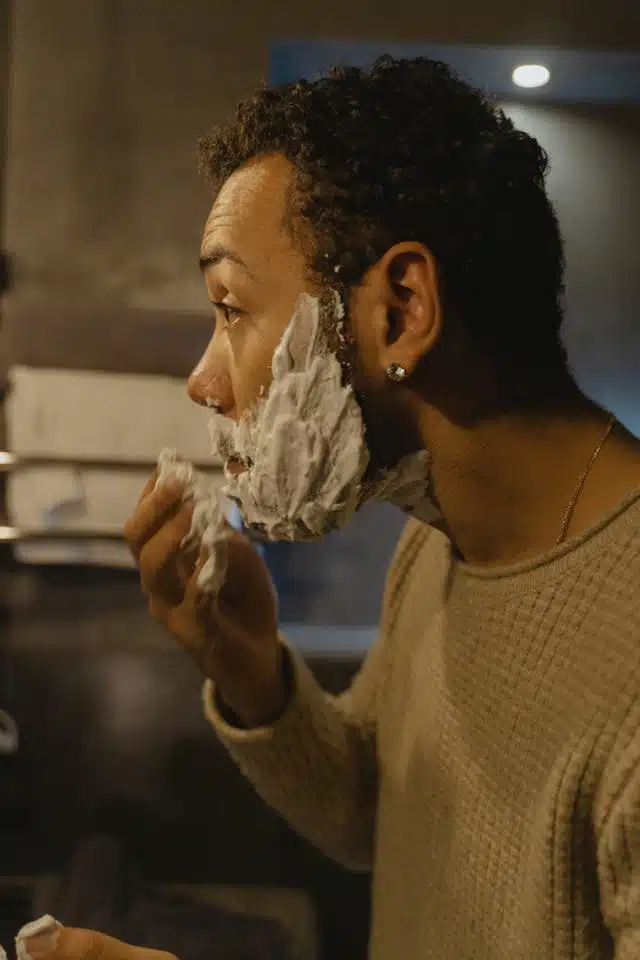Shaving is an important part of men’s hygiene and grooming. In modern society, a clean shave is sometimes required for certain jobs or simply to maintain a fresh look, especially if your beard growth isn’t uniform.
Whether you’re a beginner looking to learn how to shave or someone hoping to improve your technique, this guide will help you achieve a smooth, irritation-free shave. It’s suitable for both manual and electric razor users.

Quick Step-by-Step:
- Clean & hydrate your face
- Apply pre-shaving products (optional)
- Shave with gentle strokes
- Rinse with cold water
- Apply aftershave or moisturizer
How to Shave with a Regular Razor
1. Check Your Blade
Before you start, make sure your razor blade is sharp and in good condition. A dull blade won’t only give you a poor shave, but it also increases the risk of razor cuts. If the blade is damaged or dull, replace it.
2. Trim Down Your Beard
If your beard is several days long, trim it down before shaving. While you could shave it directly, long hairs can clog the razor, making the shave less efficient and potentially causing irritation.
3. Hydrate & Clean Your Skin
Rinse your face with warm water to soften the hairs and open your pores. Cleaning your skin beforehand ensures the razor glides smoothly, reducing the risk of cuts and irritation. The warm water also allows your pores to open, helping to remove impurities.
4. Apply Pre-Shave Oil (Optional)
If you’re prone to razor cuts or irritation, applying pre-shave oil can be a game-changer. It creates a thin protective layer that helps the razor glide easily while still giving you a close shave. Plus, it hydrates your skin, providing an additional skincare benefit.
5. Apply Shaving Cream
Use shaving cream to create a barrier between your skin and the razor. When applying, use upward motions to lift the hairs, making it easier for the razor to catch them. This also reduces the chances of getting a shaving rash.

6. Shave with Gentle Strokes
Now it’s time to shave. Use short, gentle strokes of about 2 inches (5 cm) in length. Don’t apply too much pressure—let the blade do the work. Avoid shaving the same area repeatedly, as this can irritate the skin.
7. Rinse Your Blade During the Process
Frequently rinse your razor under water while shaving to remove excess shaving cream and trapped hairs. This keeps the blade clean and ensures a smoother shave.

8. Shave with the Grain
Shaving with the grain (in the direction of hair growth) is gentler on your skin, although it may not be as close as shaving against the grain. If your skin is sensitive, it’s best to stick with shaving in the direction of hair growth to minimize irritation.
9. Use a Precision Trimmer
If your razor has a precision trimmer, use it to tackle tricky areas like the nose, sideburns, and the edges of your jawline. This ensures a neat and polished look.
10. Rinse with Cold Water
After you’ve finished shaving, rinse your face with cold water. This helps soothe irritation, tighten your skin, and close your pores to reduce the risk of infection.
11. Apply Aftershave or Moisturizer
Finally, apply aftershave or a moisturizer to hydrate and calm your skin. You can use a balm or lotion, whichever suits your skin type best. Aftershave products help soothe any post-shave irritation and keep your skin feeling fresh.
How to Shave with an Electric Razor
1. Apply Pre-Shave Oil (Optional)
Just like with a manual razor, you can use pre-shave oil before using an electric razor. While electric razors tend to cause less irritation, if you have sensitive skin, this step can still be beneficial.
2. Stretch the Skin While Shaving
One advantage of using an electric razor is that you can shave in multiple directions without much issue. To get a closer shave, use one hand to gently stretch the skin while shaving with the other. This technique helps you achieve a more effective shave.
3. Rinse Your Skin After Shaving
Once you’re done, rinse your face to remove any remaining hairs before applying aftershave.
4. Apply Aftershave or Moisturizer
Even though electric razors are gentler, they can still cause some irritation. Apply aftershave or moisturizer to keep your skin hydrated and protected.
Frequently Asked Questions (FAQ)
Do You Shave Up or Down?
Shaving up (against the grain) gives a closer shave but also increases the risk of irritation and razor cuts. Shaving down (with the grain) is gentler on your skin, though it may be less precise. If you have sensitive skin, stick to shaving with the grain for a smoother, less irritating experience.
What Should You Apply Before Using a Razor?
First, clean your face and rinse it with warm water to open the pores and soften the hair. You can then apply pre-shave oil to create a protective layer on your skin, making the razor glide smoothly and reducing irritation.
How to Shave at Home?
Most people shave at home in their bathroom. You’ll need a mirror with good lighting, access to hot and cold water for rinsing, pre-and post-shave products, a clean towel, and, of course, your preferred razor.
How Often Should You Shave?
This depends on several factors, including your hair growth, skin type, and the style you prefer. For a clean-shaven look every day, shaving daily is recommended. Others may prefer the “3-day beard” style. In any case, frequent shaving can irritate the skin, so give your skin time to recover, perhaps by taking a break over the weekend.
Shaving is a simple process, but paying attention to the details can make a big difference in the results. Be gentle, use clean tools, and prep your skin properly to avoid irritation or cuts. And if you prefer maintaining a beard rather than shaving, check out our guide on How to Trim a Beard.

